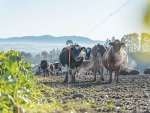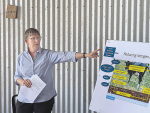It is a fact that water makes up over 50% of a dairy cows’ live weight in addition to nearly 90% of the milk she produces in her lifetime.
Cows are reported to seek water 2 – 6 times/day depending on their metabolic state and environmental conditions. At peak production, the volume of water intake can easily exceed 100 litres/cow/day and intake rates when drinking can be as high as 20 litres of water/minute.
Because of these significant numbers, it is no surprise that failure to provide a readily available fresh source of water has disastrous effects on both the cows’ wellbeing and production.
No wonder there are huge demands on-farm water supplies as temperatures climb, pasture becomes dryer and more fibrous and the hyperthermic effect of endophyte takes hold!
In December 2017, clinical signs of heat stress in Waikato herds was rife (protruding tongue, excessive salivation, lethargy, milk suppression, increased chance of clinical disease such as mastitis and in extreme cases death). In these sorts of environments, both water quality and quantity is paramount.
However, not all farms measure up in terms of providing sufficient water as any combination of issues ensue.
Water delivery and access problems
Insufficient water flow to the trough or adequate space for cows at the trough seems to be relatively common. This is often the case where herd sizes have increased but farm infrastructure improvements have failed to keep up.
Often the problem can be as basic as there not being sufficient numbers of troughs for the group of cows or the water lines are too narrow.
In these herds, farmers notice on hot afternoons the less dominant cows heading for the water trough as cows rounded up for milking.
Basically from the less dominant cow perspective ‘the bully has left the bar’ allowing them an opportunity to drink without fear of copping a flogging.
These less dominant cows failing to maintain adequate water intakes ultimately have lower dry matter intakes and dry themselves off early.
Palatability issues
Natural contaminants such as iron in water even at low levels can be sufficient to limit intake. There are many farms where iron taint can be smelt in the water with visual ‘rusting’ around wet areas (including the porcelain in the bathroom). This taint can be sufficient to significantly impact on the cows’ desire to drink.
Bacterial contamination
Bacterial contaminants of water have proven detrimental to both animal and human health over time (one high profile example is the human health issue in Havelock North during 2017). Water drawn from sources at higher risk of bacterial contamination (close proximity to effluent ponds potential run off from stand-off areas) needs to be monitored and managed properly.
Nitrates and sulphate contamination
Many of these contaminants can reduce palatability and cause animal health issues including interference with trace mineral absorption, diarrhoea, ill thrift, reproductive failure and in extreme cases increased mortality.
In summary, it is pretty simple. Because water is a vital requirement for the maintenance of normal metabolic functions in living cells, we must ensure it is abundant and of the highest quality.Failure to provide sufficient quantities of high quality water will have serious negative consequences on both the welfare of the animal and the ability of the animal to perform at optimum levels.
If you are concerned about your situation, seek advice from your Veterinarian, Advisor or Nutritionist.
• Greg Jarratt is a vet and director of Matamata Veterinary Services.
This article is brought to you by J. Swap Stockfoods.


















